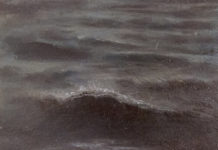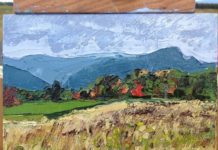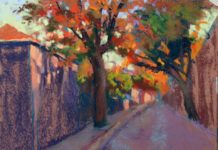
Texas painter Kim Carlton has named her upcoming show “Power and Peace,” and that’s just what she finds at her favorite place to paint.
Carlton travels two hours from her home north of Houston to get to Galveston Bay, which opens into the Gulf of Mexico. There, she finds subject matter along the Houston Ship Channel and around Galveston Island. She finds power and peace.

“Houston Ship Channel,” by Kim Carlton, 2013, oil, 11 x 14 in.
“I love the water, and I don’t care what kind of water it is — a pond, a waterfall, a river, an ocean,” she says. “It may be the mystery of what is underneath the water. It’s a visceral response. Yes, there’s the water present, and it is beautiful. But it is being used for many things — leisure, industry, food — and you see all of this going on. It’s serene and peaceful, yet there’s purpose, industry, something changing people’s lives.” Carlton sees peace in the water and big sky, and power in the factories, plants, and shipyards. It’s a pairing she also sees inland, with farms dotted with grain silos and large machines. These divergent elements catch the light in interesting ways and provide striking, abstract pieces for compositions.

Painting “Shell Collector”
Carlton describes why the Houston Ship Channel, which connects Houston to Galveston Bay, pulls her in. “I like seeing the human participation in nature,” says the artist. “It becomes something really exciting for me. The scene I painted at the Houston Ship Channel shows the slow-motion clouds — big huge things that dwarf everything. And then there’s a tiny strip of land, like a necklace.”

“Shell Collector,” by Kim Carlton, 2012, oil, 10 x 8 in.
Carlton enjoys painting portraits, so it’s not terribly surprising that she likes painting the figure in the landscape. Put the figure on the beach, and it combines several of her passions. “Figures in surf are another way of adding humanity to nature,” she says. “It gives context to the water. And once again, there is power and peace. The surf is power, the kids are peace.” She is friends with William J. Kalwick, Jr., and jumps in on opportunities to paint a model seaside when Kalwick arranges it for a class or workshop.

“Siblings Seaside,” by Kim Carlton, 2012, oil, 8 x 10 in.
In general, her plein air pieces have lighter applications of paint; she creates a fairly heavy impasto in her studio pieces. But rules are meant to be broken, as shown in her piece “Beach Hut,” which has a heavy application of pigment. It wasn’t because she had more time to paint that picture, either. It was her second plein air piece of the day, completed after she painted “Siblings Seaside.” She says she uses impasto to emphasize certain parts of the painting, and to bring forward areas in light. If a painting calls for impasto, it gets it.

“Beach Hut,” by Kim Carlton, 2012, oil, 10 x 8 in.
Carlton has been heavily influenced by the painting approach of Richard Schmid, and her palette reflects this. “I learned to paint from his book Alla Prima,” she says. “And similar to what he teaches, I like to paint with four colors. I use ultramarine blue, cadmium red, cadmium yellow pale, and transparent oxide brown. [Schmid opts for transparent oxide red.] I do this with my students, too — in fact, I have them start out painting with just transparent oxide brown to stress values.” Carlton has had considerable success painting landscapes, and she loves plein air painting, and this, too, is attributable in part to Schmid.

“Ship Channel Study,” by Kim Carlton, 2012, oil, 8 x 8 in.
“He said, ‘The best way to paint better portraits is to paint the landscape en plein air,'” recalls Carlton. “So I started painting outdoors.” The result is pieces of power and peace.




